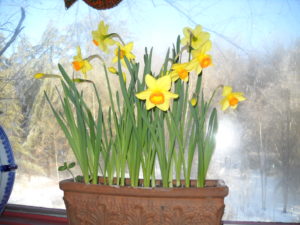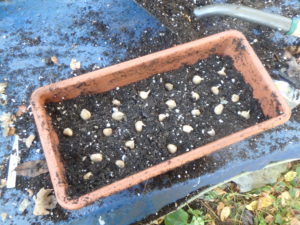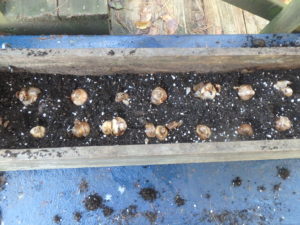Tips for Forcing Spring Bulbs Indoors
One of the easiest, and most satisfying, gardening activities I do each year is to plant tulips, daffodils, hyacinths and crocus in containers each fall. I keep them in a place that is cold, but not freezing, for 3 or 4 months, then bring them into the warmth of the house where I get gorgeous blossoms when snow may still be on the ground. I recently potted up a dozen containers with spring-blooming bulbs.
There are a few things you should know about forcing bulbs. First, you will need a cold dark place where you can store your bulbs after planting them in containers. Thirty-five to fifty degrees Fahrenheit is best, though if the temps go down below freezing for a while, that’s all right, too.
Second, it is important to select bulbs that are labeled “early” or “mid-season”, not “late-season”. It is important label each pot with the date you planted it so you can decide when to bring it into the warmth of the house. If you bring in tulips too early you will get leaves, but not blossoms. Always wait 4 months for tulips to be ready.
Daffodils only need to rest for 3 months before you bring them into the house. The smaller bulbs will do fine with even less. You will see the noses of snowdrops or crocus pop up out of the planting mix, begging for some sunshine so they can bloom.
Planting bulbs for forcing is easier than planting them outdoors. All you need are a few appropriate containers and some potting mix. I use my window box each year, forcing 25 daffodils in a box roughly 36 inches long, 7 inches deep and 7 inches from front to back. It has holes drilled in the bottom for drainage, which is important – no bulb likes soggy, poorly drained soil.
When preparing any container for planting, fill it about half way up with a good potting soil. Or you can mix the potting soil with compost to make a 50-50 mix. Or you can make your own potting mix using peat moss, compost and perlite or vermiculite.
Perlite is the white stuff you often see in commercial potting mixes – it looks like Styrofoam. But it is actually an expanded mineral that has been heated until the moisture inside it makes it pop like popcorn. It is great for keeping soil mixes lightweight and holds air, which is important for roots. Vermiculite is another expanded mineral – this one from mica. It is lightweight, but holds water.
The soil mix you use should never be allowed to dry out completely when forcing bulbs. This means you need to check on the pots once a month. If the soil mix is dry, you need to water lightly. I like to start with a mix that is quite moist when I plant the bulbs. If you use bagged peat moss in making a mix, be sure to moisten it a few days in advance. Peat moss does not quickly absorb water when it is fully dry.
So you have your pot half full of potting mix. How many bulbs can you fit into the pots? I often use rectangular clay pots that are a foot long and 5 inches deep and from front to back. If using small bulbs like crocus, I plant 20 or 25. For larger bulbs like daffodils or tulips I plant 10 or 12 in the same size pot. In a round 8-inch pot I planted 3 hyacinths this year. I plant bulbs closer in a pot than I would outdoors.
Once planted, cover the bulbs with your potting mix and pat the soil with your hands to firm it up around the bulbs. Then give the pots a light watering and place in a cool place, as described above.
If you don’t have a cold basement, you might place them in a garage or even on the steps coming up outdoors from your basement. Just remember that they must develop roots and start growing in a cold, not freezing location.
Depending where you store your bulbs, mice or squirrels will eat tulips and other bulbs indoors just as greedily indoors as out. And I’ve even had them dig daffodils out of pots and leave them in disgust –they must wonder who would want to eat them.
The easiest solution to the rodent problem is to cover each container with a piece of plywood cut to the size of the container. Just be sure to check the containers often, come spring. I’ve had bulbs start growing, hit the plywood and get all bent over.
To maximize the number of blooms you get, you can plant two layers of bulbs. Plant crocus or other small bulbs over daffodils or tulips. Just cover the bigger bulbs with soil mix, then add the small bulbs and cover them. It can be quite dramatic. I have done this outside, too.
By mid-winter I am aching to see blossoms. Since I won’t be seeing them outside, I love to have them inside. If you have had trouble with animals eating your tulips, forcing bulbs indoors is a good way to enjoy them – without fear of squirrels digging them up or deer eating the flowers. Plant them now, or certainly by mid-December, and enjoy them in early spring.
Henry can be reached at henry.homeyer@comcast.net. He is the author of 4 gardening books.





